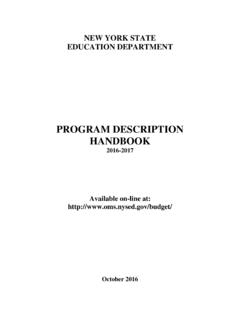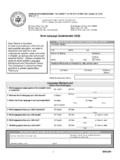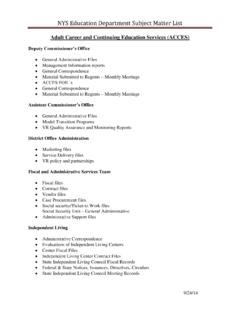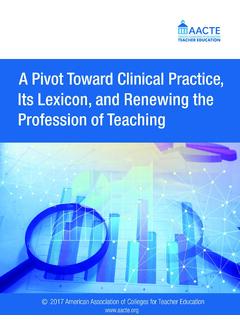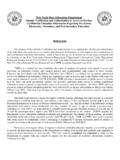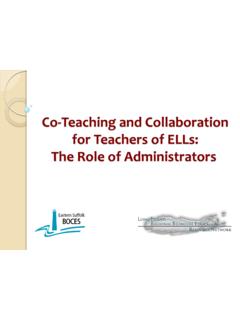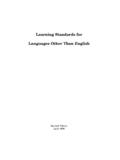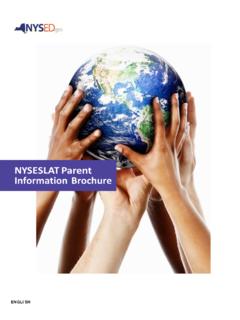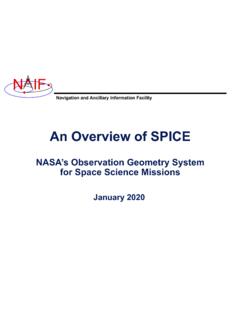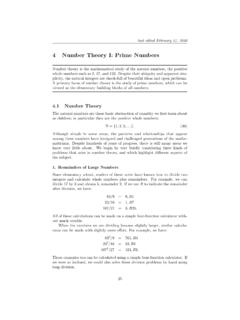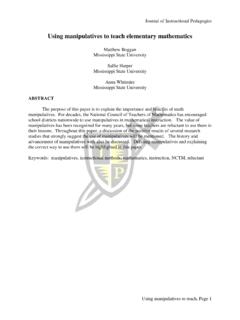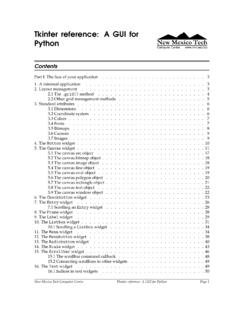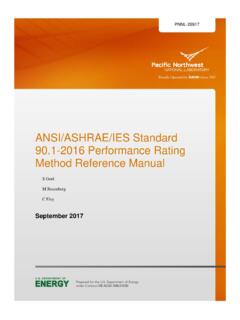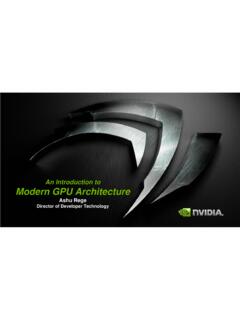Transcription of New York State Next Generation Mathematics Learning ...
1 NYSED Kindergarten Draft New York State Next Generation Mathematics Learning Standards Kindergarten Crosswalk Counting and Cardinality Cluster NYS P-12 CCLS NYS Next Generation Learning Standard Know number names and the count sequence. Count to 100 by ones and by tens. Count to 100 by ones and by tens. Count forward beginning from a given number within the known sequence (instead of having to begin at 1). Count to 100 by ones beginning from any given number (instead of beginning at 1). Write numbers from 0 to 20. Represent a number of objects with a written numeral 0-20 (with 0 representing a count of no objects). Write numbers from 0 to 20. Represent a number of objects with a written numeral 0-20 (with 0 representing a count of no objects).
2 Count to tell the number of objects. Understand the relationship between numbers and quantities; connect counting to cardinality. a. When counting objects, say the number names in the standard order, pairing each object with one and only one number name and each number name with one and only one object. b. Understand that the last number name said tells the number of objects counted. The number of objects is the same regardless of their arrangement or the order in which they were counted. c. Understand that each successive number name refers to a quantity that is one larger. d. Develop understanding of ordinal numbers (first through tenth) to describe the relative position and magnitude of whole numbers. Understand the relationship between numbers and quantities up to 20; connect counting to cardinality.
3 When counting objects, say the number names in the standard order, pairing each object with one and only one number name and each number name with one and only one object. (1:1 correspondence) Understand that the last number name said tells the number of objects counted, (cardinality). The number of objects is the same regardless of their arrangement or the order in which they were counted. Understand the concept that each successive number name refers to a quantity that is one larger. Understand the concept of ordinal numbers (first through tenth) to describe the relative position and magnitude of whole numbers. NYSED Kindergarten Draft New York State Next Generation Mathematics Learning Standards Kindergarten Crosswalk Counting and Cardinality Cluster NYS P-12 CCLS NYS Next Generation Learning Standard Count to tell the number of objects.
4 Count to answer how many? questions about as many as 20 things arranged in a line, a rectangular array, or a circle, or as many as 10 things in a scattered configuration; given a number from 1 20, count out that many objects. Answer counting questions using as many as 20 objects arranged in a line, a rectangular array, and a circle. Answer counting questions using as many as 10 objects in a scattered configuration. , How many _____ are there? Given a number from 1 20, count out that many objects. Compare numbers. Identify whether the number of objects in one group is greater than, less than, or equal to the number of objects in another group, , by using matching and counting strategies. Note: Includes groups with up to ten objects.
5 Identify whether the number of objects in one group is greater than (more than), less than (fewer than), or equal to (the same as) the number of objects in another group. , using matching and counting strategies. Note: Include groups with up to ten objects. Compare two numbers between 1 and 10 presented as written numerals. Compare two numbers between 1 and 10 presented as written numerals. , 6 is greater than 2. NYSED Kindergarten Draft New York State Next Generation Mathematics Learning Standards Kindergarten Crosswalk Operations and Algebraic Thinking Cluster NYS P-12 CCLS NYS Next Generation Learning Standard Understand addition as putting together and adding to, and understand subtraction as taking apart and taking from.
6 Represent addition and subtraction with objects, fingers, mental images, drawings, sounds ( , claps), acting out situations, verbal explanations, expressions, or equations. Note: Drawings need not show details, but should show the Mathematics in the problem. (This applies wherever drawings are mentioned in the standards) Represent addition and subtraction using objects, fingers, pennies, drawings, sounds, acting out situations, verbal explanations, expressions, equations or other strategies. Note: Drawings need not show details, but should show the Mathematics in the problem. Solve addition and subtraction word problems, and add and subtract within 10, , by using objects or drawings to represent the problem. Add and subtract within 10.
7 Solve addition and subtraction word problems within 10. , using objects or drawings to represent the problem. Decompose numbers less than or equal to 10 into pairs in more than one way, , by using objects or drawings, and record each decomposition by a drawing or equation ( , 5 = 2 + 3 and 5 = 4 + 1). Decompose numbers less than or equal to 10 into pairs in more than one way. Record each decomposition by a drawing or equation. , using objects or drawings. For any number from 1 to 9, find the number that makes 10 when added to the given number, , by using objects or drawings, and record the answer with a drawing or equation. Find the number that makes 10 when given a number from 1 to 9. Record the answer with a drawing or equation.
8 , using objects or drawings. Fluently add and subtract within 5. Fluently add and subtract within 5. Note: Fluency involves a mixture of just knowing some answers, knowing some answers from patterns, and knowing some answers from the use of strategies. NYSED Kindergarten Draft New York State Next Generation Mathematics Learning Standards Kindergarten Crosswalk Operations and Algebraic Thinking Cluster NYS P-12 CCLS NYS Next Generation Learning Standard Understand simple patterns. Duplicate, extend, and create simple patterns using concrete objects. NYSED Kindergarten Draft New York State Next Generation Mathematics Learning Standards Kindergarten Crosswalk Number and Operations in Base Ten Cluster NYS P-12 CCLS NYS Next Generation Learning Standard Work with numbers 11-19 to gain foundations for place value.
9 Compose and decompose numbers from 11 to 19 into ten ones and some further ones, , by using objects or drawings, and record each composition or decomposition by a drawing or equation (such as 18 = 10 + 8); understand that these numbers are composed of ten ones and one, two, three, four, five, six, seven, eight, or nine ones. Compose and decompose the numbers from 11 to 19 into ten ones and one, two, three, four, five, six, seven, eight, or nine ones. , using objects or drawings. NYSED Kindergarten Draft New York State Next Generation Mathematics Learning Standards Kindergarten Crosswalk Measurement and Data Cluster NYS P-12 CCLS NYS Next Generation Learning Standard Describe and compare measurable attributes. Describe measurable attributes of objects, such as length or weight.
10 Describe several measurable attributes of a single object. Describe measurable attributes of an object(s), such as length or weight, using appropriate vocabulary. , small, big, short, tall, empty, full, heavy, and light. Directly compare two objects with a measurable attribute in common, to see which object has more of / less of the attribute, and describe the difference. For example, directly compare the heights of two children and describe one child as taller/shorter. Directly compare two objects with a common measurable attribute and describe the difference. Classify objects and count the number of objects in each category. Classify objects into given categories; count the numbers of objects in each category and sort the categories by count.
